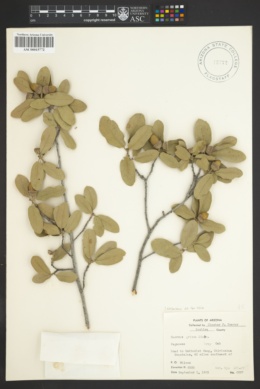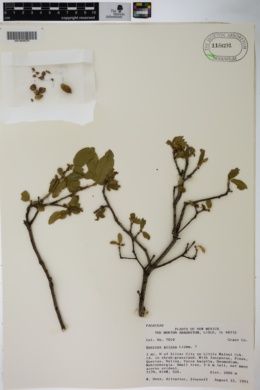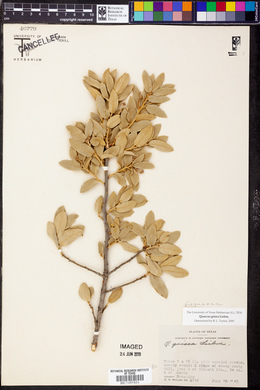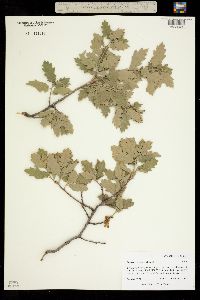Quercus grisea
|
|
|
|
Family: Fagaceae
Gray Oak, more...Arizona live oak, Arizona white oak (es: encino azul, encino blanco)
[Quercus alamosensis Trel., moreQuercus undulata var. grisea (Liebm.) Engelm.] |
Large shrubs or moderate trees , deciduous or subevergreen, to 10 m. Bark gray, fissured. Twigs gray, 1-2 mm diam., sparsely or densely stellate-tomentulose or tomentose when young. Buds dark red-brown, ovoid to subglobose, 1-2 mm, stellate hairs causing yellowish color, at least on outer scales; stipules persistent, 1-4, subulate, pubescent, at base of terminal buds. Leaves: petiole 3-10 mm. Leaf blade oblong to elliptic or ovate, (15-)25-35(-80) × (7-)15-30(-40) mm, thick and leathery, base cordate or rounded, margins minutely revolute, entire or dentate with mucronate teeth, secondary veins 6-10 on each side, branched, apex acute, sometimes obtuse, rarely rounded; surfaces abaxially dull gray-green or yellowish, minutely stellate-pubescent with interlocking hairs, secondary veins very prominent, adaxially dull green, very sparsely and minutely stellate-pubescent, secondary veins slightly raised. Acorns solitary or paired, subsessile or on peduncle 0-30 mm; cup from deeply goblet- to deeply cup-shaped, 4-10 mm deep × 8-15 mm wide, enclosing to 1/2 nut, scales broadly ovate to oblong, proximal scales slightly or markedly tuberculate and whitish canescent, tips closely appressed, red-brown, thin, glabrate; nut light brown, ovoid to narrowly ovoid or ellipsoid, 12-18 × 8-12 mm. Cotyledons connate. Flowering spring. Igneous or dolomitic slopes, oak woodlands, juniper woodlands, desert chaparral; usually above 1500 m; Ariz., N.Mex., Tex.; Mexico (Sonora, Chihuahua, and Durango). Some of the specimens referred to Quercus endemica by C. H. Muller should be placed in Q . grisea . Numerous hybrids between Quercus grisea and other white oaks, including Q . gambelii , Q . mohriana , Q . arizonica , and numerous species in northern Mexico, have been reported. In the Hueco and Quitman mountains of trans-Pecos Texas, putative hybrids of Q . grisea × Q . turbinella Greene occur.
Plant: tree; to 8 m high, the bark light grayish, furrowed; young twigs densely yellowish woolly, the older twigs losing most hairs within a year, becoming gray, remaining more or less smooth Leaves: unlobed, oblong, elliptic-oblong, oblanceolate, or lanceolate, or less often ovate, mostly widest centrally or above, 2.4-10.4 cm long, 1-4 cm wide, 2-3.4 times as long as wide, densely to sparsely covered with stellate and sometimes glandular hairs below, sparsely pubescent to glabrous above, persisting about one year, deciduous in spring or summer; stellate hairs of lower leaf surface with 4-9(-11) spreading, somewhat curled arms; apex obtuse to acute; base cordate to obtuse; petiole 3-10 mm long, woolly; midvein slightly raised to nearly flat above, prominent below; lateral veins prominent below, scarcely distinguishable from secondary veins above; secondary veins forming a reticulate pattern, somewhat raised below; blade coriaceous, dull or slightly lustrous above; margin entire or shallowly toothed, often slightly revolute, the teeth asymmetrical, apically directed INFLORESCENCE: staminate flowers in aments; pistillate flowers solitary or in groups on spikes, these sometimes abbreviated, each pistillate flower with a separate involucre Flowers: mostly wind-pollinated, unisexual, the perianth much reduced or absent; staminate flowers in heads or aments, the perianth greenish, the stamens 4-6; pistillate flowers usually tricarpellate, solitary or in clusters of about 3 or more, subtended individually or in groups by an involucre that develops into a woody cupule enclosing or subtending the mature fruit(s) Fruit: ACORNS to ca. 2 cm long, solitary or in clusters of 2 or 3 on peduncles 0-2 cm long; cap nearly hemispheric, 6-11 mm long, 10-16 mm wide, shortly woolly within; scales with thickened bases; nut-shell subglabrous within except for pubescent tip Misc: In riparian and pine forests; 1050-2200 m (3500-7200 ft); Apr-Jun (fr. Sep-Nov) REFERENCES: Landrum, Leslie R. Fagaceae. 1994. J. Ariz. - Nev. Acad. Sci. Volume 27, 203-214 Landrum 1993, Kearney and Peebles 1960, Carter 2012, Heil et al 2013 Common Name: gray oak Duration: Perennial Nativity: Native Lifeform: Tree General: Evergreen tree or shrub, most commonly growing as a small tree under 8 m but sometimes as a shrub or a even larger tree up to 20 m when growing in moist, protected situations; bark light gray, furrowed; petioles and young twigs densely yellowish- or grayish-woolly, older twigs losing most hairs within a year, remaining more or less smooth. Leaves: Unlobed, leathery, oblong to oblanceolate, less often ovate, widest centrally or above, 2.4-10.4 cm long (averaging about 3.5 cm), 1-4 cm wide, 2-3.4 times as long as wide; the base cordate or rounded; the margins sometimes minutely revolute or dentate with mucronate teeth; sparsely stellate-pubescent on the upper leaf surface, hairs denser on the lower surface; spreading; midvein prominent below, secondary veins 6-10 on each side of the primary vein; petiole 3-10 mm long, woolly. Flowers: Monoecious; staminate flowers in pendulous catkins (aments) with reduced perianth parts, 4-6 stamens per flower. Pistillate flowers in catkins of 1 to 6 flowers, also with reduced perianth parts. Fruits: Acorns to 2 cm long, solitary or in clusters of 2-3 on peduncles 0-3 cm long, cap nearly hemispheric, 6-11 mm long, 10-16 mm wide, shortly woolly within, scales with thickened bases. Ecology: Riparian and montane forests, woodlands, and savannahs from 3,500-7,000 ft (1067-2134 m); flowers in spring. Distribution: AZ, CO, NM, TX; south to c MEX. Notes: Distinguished by its ca. 4 cm long, elliptic to ovate leaves, with veins prominent and sparse to dense stellate hairs below. One of the most notorious of the Quercus hybridizers. This species was historically lumped with Q. arizonica, and at one time even had that species as a variety. Landrum suggested that there was just enough genetic variation in the whole complex to consider it as such. This guide takes them as being two separate species. Carter notes that Q. grisea is a common oak throughout NM, forming an especially major portion of forest, woodland, and savannah vegetation in the southern half of the state. Ethnobotany: The acorns were eaten raw, roasted with meat, and used ceremonially for protection from lightning, ghosts, or witches. Etymology: Quercus is the classical Latin word for oak, thought to be derived from Celtic quer, fine, and cuez, tree, while grisea means gray. Synonyms: None Editor: SBuckley 2010, FSCoburn 2015, AHazelton 2015 |
|
|
|
































































































